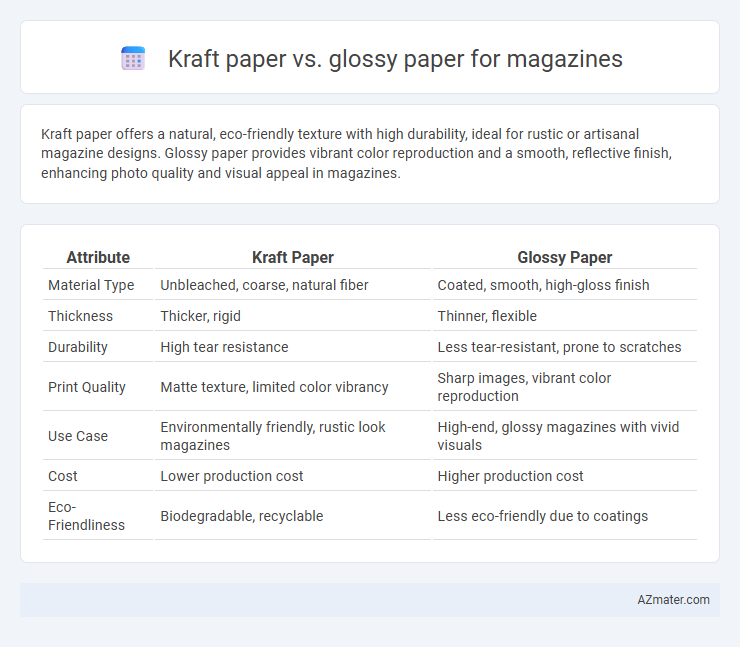Kraft paper offers a natural, eco-friendly texture with high durability, ideal for rustic or artisanal magazine designs. Glossy paper provides vibrant color reproduction and a smooth, reflective finish, enhancing photo quality and visual appeal in magazines.
Table of Comparison
| Attribute | Kraft Paper | Glossy Paper |
|---|---|---|
| Material Type | Unbleached, coarse, natural fiber | Coated, smooth, high-gloss finish |
| Thickness | Thicker, rigid | Thinner, flexible |
| Durability | High tear resistance | Less tear-resistant, prone to scratches |
| Print Quality | Matte texture, limited color vibrancy | Sharp images, vibrant color reproduction |
| Use Case | Environmentally friendly, rustic look magazines | High-end, glossy magazines with vivid visuals |
| Cost | Lower production cost | Higher production cost |
| Eco-Friendliness | Biodegradable, recyclable | Less eco-friendly due to coatings |
Introduction to Kraft Paper and Glossy Paper
Kraft paper is a durable, uncoated paper known for its natural brown color and high strength, often used in eco-friendly packaging and rustic-style magazines. Glossy paper features a smooth, shiny finish that enhances color vibrancy and image sharpness, making it popular for high-quality magazine prints emphasizing visual appeal. The choice between kraft and glossy paper impacts the magazine's tactile experience, print quality, and environmental footprint.
Key Differences in Appearance
Kraft paper features a matte, textured surface with a natural brown tone that gives magazines an earthy, rustic look, while glossy paper offers a smooth, shiny finish that enhances color vibrancy and sharpness. The roughness of kraft paper absorbs ink differently, resulting in muted colors and a more organic feel compared to the reflective quality of glossy paper that emphasizes contrast and detail. Kraft paper is often chosen for eco-friendly or artisanal publications, whereas glossy paper suits high-end magazines aiming for polished, visually striking imagery.
Printing Quality and Color Reproduction
Kraft paper offers a rustic, textured surface that enhances printed materials with a natural finish but limits color vibrancy and sharpness, making it less ideal for magazines requiring vivid and detailed images. Glossy paper features a smooth, reflective coating that significantly improves printing quality by producing sharper images and brighter, more accurate color reproduction, crucial for high-impact visual content in magazines. The choice between Kraft and glossy paper directly affects the magazine's visual appeal, with glossy paper preferred for rich color depth and Kraft paper suited for a more organic, muted aesthetic.
Durability and Tear Resistance
Kraft paper offers superior durability and tear resistance compared to glossy paper due to its uncoated, fibrous composition, making it ideal for magazines requiring long-lasting pages. Glossy paper, while providing vibrant image quality, tends to be more prone to tearing and damage under heavy use because of its smooth, coated surface. For magazines emphasizing resilience and frequent handling, kraft paper presents a more robust option that withstands wear and tear effectively.
Environmental Impact and Sustainability
Kraft paper for magazines offers superior environmental benefits due to its biodegradable and recyclable nature, often made from unbleached, renewable wood fibers with minimal chemical processing. Glossy paper, typically coated with plastic or clay, poses sustainability challenges because its recycling process is more energy-intensive and can release harmful substances into the environment. Choosing kraft paper supports eco-friendly publishing by reducing carbon footprint and waste, aligning with sustainable production practices.
Tactile Experience and Reader Perception
Kraft paper offers a coarse, natural texture that enhances the tactile experience by providing a rustic and organic feel, often associated with eco-friendly and artisanal brands. Glossy paper provides a smooth, reflective surface that intensifies color vibrancy and sharpness, creating a sleek and polished appearance that appeals to readers seeking sophistication and high-end visuals. Reader perception often links Kraft paper with authenticity and sustainability, while glossy paper conveys modernity and premium quality in magazine printing.
Cost Comparison: Kraft vs Glossy Paper
Kraft paper typically costs less than glossy paper due to its uncoated, recycled fiber composition, making it a budget-friendly option for magazine printing. Glossy paper, featuring a smooth, coated finish, demands higher production expenses, resulting in increased overall costs. Publishers aiming to balance quality with affordability often choose kraft paper for eco-friendly, cost-effective magazines, whereas glossy paper suits high-end, visually vibrant publications despite the higher price.
Suitable Magazine Genres for Each Paper Type
Kraft paper is ideal for magazines focused on eco-friendly topics, artisanal crafts, and rustic lifestyle genres due to its natural, textured appearance that appeals to environmentally conscious readers. Glossy paper suits high-end fashion, beauty, and technology magazines as it enhances photo quality and vibrant colors, capturing attention with a sleek, polished finish. Choosing the right paper type directly supports the magazine's brand identity and target audience engagement.
Brand Image and Audience Appeal
Kraft paper's natural, rustic texture enhances a brand's eco-friendly and artisanal image, appealing to audiences valuing sustainability and authenticity in magazine design. Glossy paper offers vibrant color reproduction and sharp imagery, making it ideal for brands targeting fashion-forward, visually-driven readers who prioritize high-impact aesthetics. Choosing between Kraft and Glossy paper significantly influences brand perception and audience engagement by aligning material choice with the magazine's core values and market demographics.
Final Considerations and Recommendations
Kraft paper offers a rustic, eco-friendly appeal with excellent durability and recyclability, making it ideal for magazines targeting environmentally conscious readers or promoting a natural aesthetic. Glossy paper provides vibrant colors and sharp image reproduction, enhancing visual appeal and attracting mainstream audiences seeking high-quality photo finishes. For a balanced approach, choose kraft paper for niche, sustainable publications and glossy paper for visually rich, commercial magazines requiring striking imagery.

Infographic: Kraft paper vs Glossy paper for Magazine
 azmater.com
azmater.com